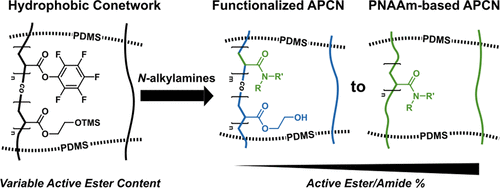当前位置:
X-MOL 学术
›
Macromolecules
›
论文详情
Our official English website, www.x-mol.net, welcomes your
feedback! (Note: you will need to create a separate account there.)
Wide Range of Functionalized Poly(N-alkyl acrylamide)-Based Amphiphilic Polymer Conetworks via Active Ester Precursors
Macromolecules ( IF 5.1 ) Pub Date : 2018-07-11 00:00:00 , DOI: 10.1021/acs.macromol.8b00841 Sebastian Ulrich 1 , Amin Sadeghpour , René M. Rossi , Nico Bruns 1 , Luciano F. Boesel
Macromolecules ( IF 5.1 ) Pub Date : 2018-07-11 00:00:00 , DOI: 10.1021/acs.macromol.8b00841 Sebastian Ulrich 1 , Amin Sadeghpour , René M. Rossi , Nico Bruns 1 , Luciano F. Boesel
Affiliation

|
A versatile strategy for the fabrication of functional and nanostructured poly(N-alkyl acrylamide)-based amphiphilic polymer conetworks (APCNs) from hydrophobic precursor networks is presented. The active ester monomer pentafluorophenyl acrylate (PFPA) fulfills a dual role: it provides miscibility with hydrophobic macromonomer cross-linkers and activates the acrylate for amidation reactions. Thereby, it acts as a general hydrophobic masking group for N-alkyl acrylamides, and enables the transformation of PFPA-based hydrophobic precursor networks into a multitude of different poly(N-alkyl acrylamide)-l-PDMS APCNs. These optically transparent APCNs possess nanophase-separated morphologies with domain sizes in the nanometer range. Variation of the amide results in different types of APCNs, despite them being derived from the same precursor network and having identical network structures. Accordingly, the properties of these APCNs can be tailored to the desired application by simple variation of the amide functionality. Furthermore, the combination of PFPA with another hydrophobically masked monomer allows for the fabrication of APCNs with small yet precisely defined amounts of functional amide units in the hydrophilic phase. A controlled functionalization of APCNs with pendant groups such as pH-responsive imidazole, fluorescent dyes, and biotin for specific protein binding is achieved, greatly expanding the functionality of the APCNs. Such functionalized APCNs could find application as stimuli-responsive drug delivery membranes, smart hydrogels, biosensors, or matrices for biocatalysis.
中文翻译:

通过活性酯前体的各种功能化的基于聚(N-烷基丙烯酰胺)的两亲聚合物共网络
提出了一种从疏水性前体网络制备功能性和纳米结构的聚(N-烷基丙烯酰胺)基两亲聚合物共网络(APCN)的通用策略。活性酯单体丙烯酸五氟苯基酯(PFPA)具有双重作用:它可与疏水性大分子单体交联剂混溶,并活化丙烯酸酯用于酰胺化反应。由此,它作为一个一般的疏水性掩蔽基团Ñ -烷基丙烯酰胺,和使基于PFPA疏水前体的网络转变成不同的聚(一许多ñ -烷基丙烯酰胺) -升-PDMS APCN。这些光学透明的APCN具有纳米相分离的形态,其畴尺寸在纳米范围内。尽管酰胺衍生自相同的前体网络并具有相同的网络结构,但酰胺的变化会导致产生不同类型的APCN。因此,这些APCN的性质可以通过酰胺官能团的简单变化而适合所需的应用。此外,PFPA与另一种疏水性掩蔽单体的组合允许制备在亲水相中具有少量但精确限定的功能酰胺单元的APCN。具有侧基的APCN的受控功能化(例如pH响应的咪唑,荧光染料和生物素)可实现特异性蛋白质结合,从而大大扩展了APCN的功能。
更新日期:2018-07-11
中文翻译:

通过活性酯前体的各种功能化的基于聚(N-烷基丙烯酰胺)的两亲聚合物共网络
提出了一种从疏水性前体网络制备功能性和纳米结构的聚(N-烷基丙烯酰胺)基两亲聚合物共网络(APCN)的通用策略。活性酯单体丙烯酸五氟苯基酯(PFPA)具有双重作用:它可与疏水性大分子单体交联剂混溶,并活化丙烯酸酯用于酰胺化反应。由此,它作为一个一般的疏水性掩蔽基团Ñ -烷基丙烯酰胺,和使基于PFPA疏水前体的网络转变成不同的聚(一许多ñ -烷基丙烯酰胺) -升-PDMS APCN。这些光学透明的APCN具有纳米相分离的形态,其畴尺寸在纳米范围内。尽管酰胺衍生自相同的前体网络并具有相同的网络结构,但酰胺的变化会导致产生不同类型的APCN。因此,这些APCN的性质可以通过酰胺官能团的简单变化而适合所需的应用。此外,PFPA与另一种疏水性掩蔽单体的组合允许制备在亲水相中具有少量但精确限定的功能酰胺单元的APCN。具有侧基的APCN的受控功能化(例如pH响应的咪唑,荧光染料和生物素)可实现特异性蛋白质结合,从而大大扩展了APCN的功能。











































 京公网安备 11010802027423号
京公网安备 11010802027423号